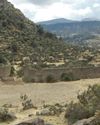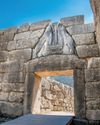Try GOLD - Free
Archaeology Magazine - September/October 2023

Go Unlimited with Magzter GOLD
Read Archaeology along with 10,000+ other magazines & newspapers with just one subscription
View CatalogSubscribe only to Archaeology
Cancel Anytime.
(No Commitments) ⓘIf you are not happy with the subscription, you can email us at help@magzter.com within 7 days of subscription start date for a full refund. No questions asked - Promise! (Note: Not applicable for single issue purchases)
Digital Subscription
Instant Access ⓘSubscribe now to instantly start reading on the Magzter website, iOS, Android, and Amazon apps.
Verified Secure
payment ⓘMagzter is a verified Stripe merchant.
In this issue
Learn how people throughout the ancient world adopted lions as sacred symbols of power and protection. Travel to northern Ukraine, where archaeologists are unearthing the remnants of a Cossack capital that the Russian czar Peter the Great burned to the ground in 1708. Take a virtual peek beneath an Egyptian mummy’s wrappings with researchers using state-of-the-art CT scanning technology. And journey with us to the slopes of Mount Vesuvius, where survivors of the devastating A.D. 79 eruption rebuilt their lives in lavish fashion. In these stories—and so many more—this issue of ARCHAEOLOGY brings the past to life.
Archaeology Magazine Description:
Publisher: Archaeological-Institute-of-America
Category: Culture
Language: English
Frequency: Bi-Monthly
Each issue of Archaeology offers the grit, and the magic, of archaeological discovery with an up-close view of sites around the world. Readers can look forward to the latest news, vivid storytelling, and compelling photography. Archaeology brings the human past to life.
Recent issues

November/December 2025

September/October 2025

July/August 2025

May/June 2025

March/April 2025

January/February 2025

November/December 2024

September/October 2024

July/August 2024

May/June 2024

March/April 2024

January/February 2024

November/December 2023

July/August 2023

May/June 2023

March/April 2023

January/February 2023

November/December 2022

September/October 2022

July/August 2022

May/June 2022

March/April 2022

January/February 2022

November/December 2021

September/October 2021

July/August 2021

May/June 2021

March/April 2021

January/February 2021
Related Titles

The New Yorker

Travel, Taste and Tour

Russian Life

Faces - The Magazine of People, Places and Cultures for Kids

Scoop USA Newspaper

Good Old Days

VOZ Magazine

The Iowan

Whispering Wind

Chtenia: Readings from Russia

Dots x Circles Illustration

Sculpture

Study in the USA

24 Characteristics of a Genius

Carvell Family History

Luster Magazine

BBC History UK

Best of British

The Scots Magazine

Who Do You Think You Are? Magazine

All About History UK

History of War

The Overhead Railway

New Brighton

The Way We Worked

Scottie Road

Liverpool Then

100 Years of the Liver Birds

Liverpool Then Volume 3

The Way We Lived






































